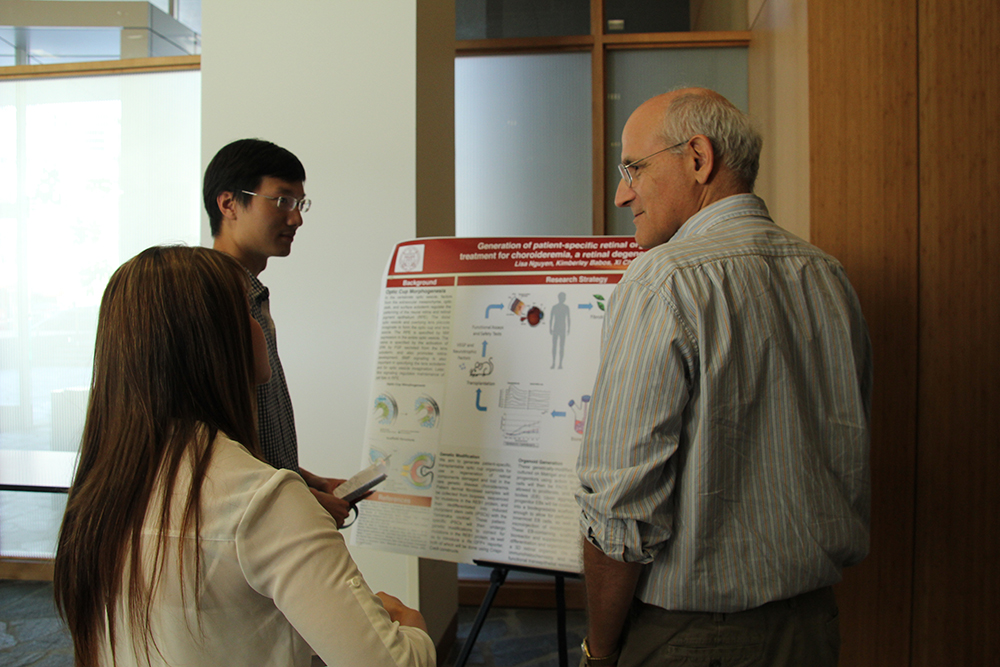
Video by Alric Devotta
The students in the new PhD program in Development, Stem Cells, and Regenerative Medicine recently presented some ideas that would give Dr. Frankenstein a run for his money.
For the summer course DSR 542 Principles of Developmental and Stem Cell Biology, eight teams of students presented elevator pitches and scientific posters outlining strategies for rebuilding the body’s organ systems.
“We really try and do an intensive experience for the new students coming into our program,” said Gage Crump, director of the Development, Stem Cells, and Regenerative Medicine program, one of the PhD Programs in Biomedical and Biological Sciences (PIBBS). “And so rather than having a didactic class where the professor gets up there and just lectures everyone for the whole time, we wanted to have it be more interactive.”
During the course, students discussed the primary scientific literature; gained hands-on experience with stem cell culture, embryology and imaging; and unleashed their imaginations on the challenges of organ regeneration.
“The goal is not only to use the principles of developmental biology, but also to brainstorm wacky, crazy ideas,” said Crump. “Some may work, some may not, but the entire process stimulates the logical flow of how you would come up with a new strategy to induce regeneration.”
Many of the students described the techniques proposed in their posters as “shooting the moon.”
One team suggested a potential treatment for retinal degeneration, which causes blindness. Their approach involved reprogramming patients’ skin cells into 3D retinal “organoids” on a biodegradable scaffold.
During the semester, this team had the opportunity to discuss their idea with USC Stem Cell scientist David Hinton, who is collaborating with colleague Mark Humayun to deliver retinal-support cells into the eyes of patients with macular degeneration in a clinical trial.
“It was cool to hear from an expert in the field what we didn’t think about, what people are thinking about and how people are approaching different things,” said student Kimberley Babos. “I mean, it was a little intimidating, but at the same time it was educational.”
Another team did a project about regenerating the cells of the inner ear to treat hearing loss. These cells don’t regenerate in mammals, but do regenerate in birds. Building on this curious fact, the team proposed a quest to identify the genes that enable this regeneration in birds and might induce similar regeneration in mammals.
“Overall, it was a really good learning experience,” said student Louise Menendez. “It was helpful to learn some of the basic ideas behind making a poster. It’s definitely something I’ll be using in the future a lot.”
Elisabeth Rutledge, whose team explored a method for using stem cells to produce hearts suitable for transplantation without immune rejection, found the course equally valuable.
“I actually really liked the three-minute elevator pitch,” she said. “It was really good practice to think about what’s the most important thing, and how do I make it sound exciting to get people interested in coming by my poster later on. So it was really helpful in that sense.”
Other teams detailed equally creative approaches to regenerating the kidney, liver, blood system, skin and teeth.
“The course is an innovative way to engage students in thinking about the challenges of generating the different replacement parts for our body systems,” said Andy McMahon, chair of the Department of Stem Cell Biology and Regenerative Medicine. “We need to inspire this kind of out-of-the-box thinking in the next generation of stem cell researchers, who will be the ones translating today’s ideas into tomorrow’s cures.”
